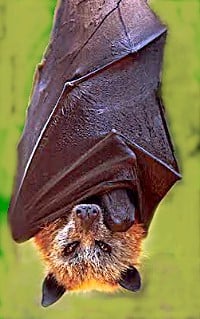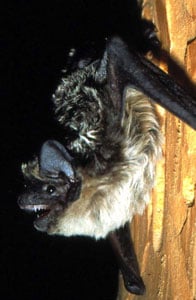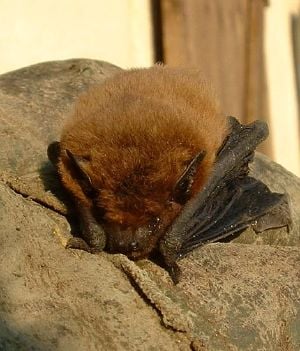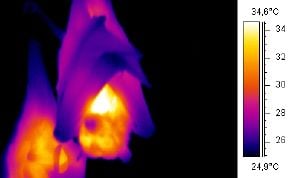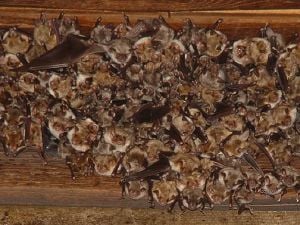Bat
| Bats
| ||||||||||||
|---|---|---|---|---|---|---|---|---|---|---|---|---|
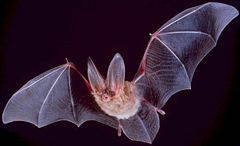 Townsends's Big-eared Bat, Corynorhinus townsendii
| ||||||||||||
| Scientific classification | ||||||||||||
| ||||||||||||
|
Megachiroptera |
A bat is a mammal in the order Chiroptera.
Classification
Bats are divided into two distinct groups (or superorders):
- Megachiroptera (megabats)
- Microchiroptera (microbats/echolocating bats)
Despite the name, not all megabats are larger than all microbats.
Megabats are found in Africa and Asia. They eat fruit, nectar or pollen, with some supplementing their diets with a few insects. Some megabat species are known as flying foxes. There are about 170 species of megabats. Microbats are found on all continents except Antarctica. Most of them eat insects, while a few eat fruit, nectar, or small animals, or drink the blood of large animals. There are about 800 species of microbats (Richardson 2002).
- ORDER CHIROPTERA (Ky-rop`ter-a) (Gr. cheir, hand, + pteron, wing)
- Suborder Megachiroptera (megabats)
- Pteropodidae
- Suborder Microchiroptera (microbats)
- Superfamily Emballonuroidea
- Emballonuridae (Sac-winged or Sheath-tailed bats)
- Superfamily Molossoidea
- Antrozoidae (Pallid bats)
- Molossidae (Free-tailed bats)
- Superfamily Nataloidea
- Furipteridae (Smoky bats)
- Myzopodidae (Sucker-footed bats)
- Natalidae (Funnel-eared bats)
- Thyropteridae (Disk-winged bats)
- Superfamily Noctilionoidea
- Mormoopidae (Ghost-faced or Moustached bats)
- Mystacinidae (New Zealand short-tailed bats)
- Noctilionidae (Bulldog bats or Fisherman bats)
- Phyllostomidae (Leaf-nosed bats)
- Superfamily Rhinolophoidea
- Megadermatidae (False vampires)
- Nycteridae (Hollow-faced or Slit-faced bats)
- Rhinolophidae (Horseshoe bats)
- Superfamily Rhinopomatoidea
- Craseonycteridae (Bumblebee Bat or Kitti's Hog-nosed Bat)
- Rhinopomatidae (Mouse-tailed bats)
- Superfamily Vespertilionoidea
- Vespertilionidae (Vesper bats or Evening bats)
- Superfamily Emballonuroidea
- Suborder Megachiroptera (megabats)
Size
Most bats are very small, for mammals. The smallest bat (also the smallest mammal) is the bumblebee bat of Thailand (Craseonycteris thonglongyai) which weighs only 2 grams. The largest bat is the greater flying fox which weighs 1500 grams (3.3 lbs). The largest bat in Canada is the hoary bat (Lasiurus cinereus) which weighs about 30 grams (0.9 oz). It could be sent through the mail with one first class Canandian postage stamp. The bat with the largest wing span is the flying fox (Pter
Flight
The the most distinguishing feature of bats is that their forelimbs are developed as wings, making them the only mammals in the world naturally capable of flight. (Other mammals, such as flying squirrels and flying opossums, can glide for limited distances). The word Chiroptera can be translated from the Greek words for "hand wing," as the structure of the open wing is very similar to an outspread human hand with a membrane (patagium) between the fingers that also stretches between hand and body.
Bats fly with a swimming-like motion in which they grab pockets of air with their hand membranes. The fastest bat is the Mexican free-tailed bat (Tadarida brasiliensis) which can reach speeds of 40 mph in level flight and 80 mph in dives. It has also been known to fly as high as 10,000 feet to take advantage of high-altitude winds. Many bats can hover, like hummingbirds, in order to pick insects off surfaces or to feed from flowers (Voelker 1986).
Because their wings are much thinner than those of birds, bats can manoeuvre more quickly and more precisely than birds. The surface of their wings are also equipped with touch-sensitive receptors on small bumps called Merkel cells, found in most mammals, including humans. But these sensitive areas are different in bats as each bump has a tiny hair in the centre, making it even more sensitive, and allowing the bat to detect and collect information about the air flowing over its wings. An additional kind of receptor cell is found in the wing membrane of species that use their wings to catch prey. This receptor cell is sensitive to the stretching of the membrane. The cells are concentrated in areas of the membrane where insects hit the wings when the bats capture them (Calhoun 2005).
Bat flight requires a great deal of energy. To power its flight muscles a typical bat's heart rate increases from 300 to 1000 beats per minute when it flys. In order to keep active bats need a good supply of high-energy food at least every few days. In places where this is not possible many bats hibernate in winter to save energy (Richardson 2002).
Echolocation
By emitting high-pitched sounds and listening to the echoes, also known as sonar, microbats locate prey and other nearby objects. This is the process of echolocation, an ability they share with dolphins and some whales. Some macrobats also use echolocation, but the sounds are produced by tounge clicks and are used to find their way in caves and other dark places not to find food.
Echolocating microbats produce short bursts of sound, up to 200 per second. The sounds are too high pitched for humans to hear but are extremely loud, up to 110 decibels. By using echolocation microbats can detect flying insects and avoid obsticles to their flight, even in total darkness. The external ears of most microbats are very large for their size and are often shaped and folded in complex ways to enhance their reception of echolocation signals. Some bats also have a "noseleaf", a structure on the nose which is involved in echolocation (Fenton 1998, Voelker 1986).
Two groups of moths exploit the bats' senses: tiger moths produce ultrasonic signals to warn the bats that the moths are chemically-protected (aposematism) (this was once thought to be a form of "radar jamming", but this theory has been disproved); the moths Noctuidae have a hearing organ called a tympanum which responds to an incoming bat signal by causing the moth's flight muscles to twitch erratically, sending the moth into random evasive manoeuvres.
Reproduction
Mother bats usually have only one offspring per year, and they are viviparous. A baby bat is referred to as a pup.[1] Pups are usually left in the roost when they are not nursing. However, a newborn bat can cling to the fur of the mother and be transported, although they soon grow too large for this. It would be difficult for an adult bat to carry more than one young, but normally only one young is born. Bats often form nursery roosts, with many females giving birth in the same area, be it a cave, a tree hole, or a cavity in a building. Mother bats are able to find their young in huge colonies of millions of other pups. Pups have even been seen to feed on other mothers' milk if their mother is dry. Only the mother cares for the young, and there is no continuous partnership with male bats.
The ability to fly is congenital, but at birth the wings are too small to fly. Young microbats become independent at the age of 6 to 8 weeks, megabats not until they are four months old. At the age of two years, bats are sexually mature.
A single bat can live over 20 years, but the bat population growth is limited by the slow birth rate.[2]
Behavior
Most microbats are active at night or at twilight.
Many bats migrate, while others pass into torpor in cold weather but rouse themselves and feed when warm spells permit insect activity. Yet others retreat to caves for winter and hibernate for six months.
The social structure of bats varies, with some bats leading a solitary life and others living in caves colonized by more than a million bats. The fission-fusion social structure is seen among several species of bats. "Fusion" refers to the grouping of large numbers of bats in one roosting area and "fission" is the breaking apart and mixing of subgroups, with individual bats switching roosts with others and often ending up in different trees and with different roostmates.
Studies also show that bats make all kinds of sounds to communicate with others. Scientists in the field have listened to bats and have been able to identify some sounds with some behaviour bats will make right after the sounds are made.
As vectors for pathogens
Bats are natural reservoirs or vectors for a large number of zoonotic pathogens[3] including rabies,[4] severe acute respiratory syndrome (SARS),[5] Henipavirus (ie. Nipah virus and Hendra virus)[6] and possibly ebola virus.[7] Their high mobility, broad distribution, social behaviour (communal roosting, fission-fusion social structure) and close evolutionary relationship to humans make bats favourable hosts and disseminators of disease. Many species also appear to have a high tolerance for harbouring pathogens and often do not develop disease while infected.
Only 0.5% of bats carry rabies. However, of the very few cases of rabies reported in the United States every year, most are caused by bat bites[citation needed]. Although most bats do not have rabies, those that do may be clumsy, disoriented, and unable to fly, which makes it more likely that they will come into contact with humans. Although one should not have an unreasonable fear of bats, one should avoid handling them or having them in one's living space, as with any wild animal. If a bat is found in living quarters near a child, mentally handicapped person, intoxicated person, sleeping person, or pet, the person or pet should receive immediate medical attention for rabies. Bats have very small teeth and can bite a sleeping person without necessarily being felt.
If a bat is found in a house and the possibility of exposure cannot be ruled out, the bat should be sequestered and an animal control officer called immediately, so that the bat can be analysed. This also applies if the bat is found dead. If it is certain that nobody has been exposed to the bat, it should be removed from the house. The best way to do this is to close all the doors and windows to the room except one to the outside. The bat should soon leave.
Due to the risk of rabies and also due to health problems related to their guano, bats should be excluded from inhabited parts of houses. For full detailed information on all aspects of bat management, including how to capture a bat, what to do in case of exposure, and how to bat-proof a house humanely, see the Centers for Disease Control's website on bats and rabies. In certain countries, such as the United Kingdom, it is illegal to handle bats without a license.
Where rabies is not endemic, as throughout most of Western Europe, small bats can be considered harmless. Larger bats can give a nasty bite. They should be treated with the respect due to any wild animal.
Cultural aspects
The bat is sacred in Tonga and West Africa and is often considered the physical manifestation of a separable soul. Bats are closely associated with vampires, who are said to be able to shapeshift into bats, fog, or wolves. Bats are also a symbol of ghosts, death, and disease. Among some Native Americans, such as the Creek, Cherokee and Apache, the bat is a trickster spirit. Chinese lore claims the bat is a symbol of longevity and happiness, and is similarly lucky in Poland and geographical Macedonia and among the Kwakiutl and Arabs. The bat is also a heraldic animal of the Spanish autonomous community of Valencia.
In Western Culture, the bat is often a symbol of the night and its foreboding nature. The bat is a primary animal associated with fictional characters of the night, both villains like Dracula and the Future Predator from the 2007 TV series Primeval and heroes like Batman. The association of the fear of the night with the animal was treated as a literary challenge by Kenneth Oppel, who created a best selling series of novels, beginning with Silverwing, which feature bats as the central heroic figures much in a similar manner as the classic novel Watership Down did for rabbits. An old wives' tale has it that bats will entangle themselves in people's hair. A likely root to this myth is that insect-eating bats seeking prey may dive erratically toward people, who attract mosquitoes and gnats, leading the squeamish to believe that the bats are trying to get in their hair.
In the United Kingdom all bats are protected under the Wildlife and Countryside Acts, and even disturbing a bat or its roost can be punished with a heavy fine.
Austin, Texas, under the Congress Avenue bridge, is the summer home to North America's largest urban bat colony, an estimated 1,500,000 Mexican free-tailed bats, who eat an estimated 10,000 to 30,000 pounds of insects each night and attract 100,000 tourists each year.
In Sarawak, Malaysia bats are protected species under the Wildlife Protection Ordinance 1998 (see Malaysian Wildlife Law). The large Naked bat (see Mammals of Borneo) and Greater Nectar bat are consumed by the local communities.
Bat houses
Many people put up bat houses to attract bats just like many people put up birdhouses to attract birds. Reasons for this vary, but mostly center around the fact that bats are the primary nocturnal insectivores in most if not all ecologies. Bat houses can be made from scratch, made from kits, or bought ready made. Plans for bat houses exist on many web sites, as well as guidelines for designing a bat house[citation needed]. Some conservation societies are giving away free bat houses to bat enthusiasts worldwide[citation needed].
A bat house constructed in 1991 at the University of Florida campus next to Lake Alice in Gainesville has a population of over 100,000 free-tailed bats.[8]
ReferencesISBN links support NWE through referral fees
- Calhoun, M. 2005. "Bats Use Touch Receptors on Wings to Fly, Catch Prey, Study Finds". Ohio University. Retrieved September 3, 2007.
- Fenton, M. 1998. The Bat: Wings in the Night Sky. Buffalo, NY: Firefly Press. ISBN 1552092534
- Richardson, P. 2002. Bats. Washington, DC: Smithsonian Intitution Press. ISBN 1588340201
- Schober, W. 1984. The Lives of Bats. New York: Arco Publishing, Inc. ISBN 0668059931
- Voelker, W. 1986. The Natural History of Living Mammals. Medford, NJ: Plexus Publishing, Inc. ISBN 0937548081
- ↑ "Baby bats under threat from wet weather", Bat Conservation Trust, 3 July 2007, retrieved 2 August, 2007
- ↑ http://www.batworld.org/main/main.html Retrieved 22 October 2006.
- ↑ Wong, S, Lau, S, Woo, P, Yuen, KY. (2007). Bats as a continuing source of emerging infections in humans. Rev Med Virol. 17(2):67–91.
- ↑ McColl, KA, Tordo, N, Aquilar Setien, AA. (2000). Bat lyssavirus infections. Rev Sci Tech. 19(1):177–196.
- ↑ Li, W, Shi, A, Yu, M et al (2005) Bats are natural reservoirs of SARS-like coronaviruses. Science 310(5748):676–679.
- ↑ Halpin K, Young PL, Filed HE, Mackenzie JS. Isolation of Hendra virus from pteropid bats: a natural reservoir of Hendra virus. Journal of General Virology 2000; 81:1927–1932. PMID 10900029. Available from http://vir.sgmjournals.org/cgi/content/full/81/8/1927
- ↑ Leroy, EM, Kimulugui, B, Pourrut, X et al. (2005). Fruit bats as reservoirs of Ebola virus. Nature. 438:575–576.
- ↑ Nordlie, Tom (2001-10-29). Backyard Bat Houses Promote Pest Control, Says UF Expert. UF News pp. 30. University of Florida. Archived from the original on 2001-11-30. Retrieved 2007-06-18.
- General references
- Greenhall, Arthur H. 1961. Bats in Agriculture. A Ministry of Agriculture Publication. Trinidad and Tobago.
- Nowak, Ronald M. 1994. " Walker's BATS of the World". The John Hopikins University Press, Baltimore and London.
- John D. Pettigrew's summary on Flying Primate Hypothesis
- Altringham, J.D. 1998. Bats: Biology and Behaviour. Oxford: Oxford University Press.
- Dobat, K.; Holle, T.P. 1985. Blüten und Fledermäuse: Bestäubung durch Fledermäuse und Flughunde (Chiropterophilie). Frankfurt am Main: W. Kramer & Co. Druckerei.
- Fenton, M.B. 1985. Communication in the Chiroptera. Bloomington: Indiana University Press.
- Findley, J.S. 1995. Bats: a Community Perspective. Cambridge: Press Syndicate of the University of Cambridge.
- Fleming, T.H. 1988. The Short-Tailed Fruit Bat: a Study in Plant-Animal Interactions. Chicago: The University of Chicago Press.
- Kunz, T.H. 1982. Ecology of Bats. New York: Plenum Press.
- Kunz, T.H.; Racey, P.A. 1999. Bat Biology and Conservation. Washington: Smithsonian Institution Press.
- Kunz, T.H.; Fenton, M.B. 2003. Bat Ecology. Chicago: The University of Chicago Press.
- Neuweiler, G. 1993. Biologie der Fledermäuse. Stuttgart: Georg Thieme Verlag.
- Nowak, R.M. 1994. Walker's Bats of the World. Baltimore: The Johns Hopkins University Press.
- Richarz, K. & Limbruner, A. 1993. The World of Bats. Neptune City: TFH Publications.
- Twilton, B. 1999. My Life as The Bat. Liverpool Hope University press
External links
- Texas Parks and Wildlife Bat Page
- University of Michigan Museum of Zoology
- Bats and Tarsier
- Tree of Life
- Bat evolution linked to warming
- Microbat Vision
- Bats of Australia
| Mammals |
|---|
| Monotremata (platypus, echidnas) |
|
Marsupialia: | Paucituberculata (shrew opossums) | Didelphimorphia (opossums) | Microbiotheria | Notoryctemorphia (marsupial moles) | Dasyuromorphia (quolls and dunnarts) | Peramelemorphia (bilbies, bandicoots) | Diprotodontia (kangaroos and relatives) |
|
Placentalia: Cingulata (armadillos) | Pilosa (anteaters, sloths) | Afrosoricida (tenrecs, golden moles) | Macroscelidea (elephant shrews) | Tubulidentata (aardvark) | Hyracoidea (hyraxes) | Proboscidea (elephants) | Sirenia (dugongs, manatees) | Soricomorpha (shrews, moles) | Erinaceomorpha (hedgehogs and relatives) Chiroptera (bats) | Pholidota (pangolins)| Carnivora | Perissodactyla (odd-toed ungulates) | Artiodactyla (even-toed ungulates) | Cetacea (whales, dolphins) | Rodentia (rodents) | Lagomorpha (rabbits and relatives) | Scandentia (treeshrews) | Dermoptera (colugos) | Primates | |
Credits
New World Encyclopedia writers and editors rewrote and completed the Wikipedia article in accordance with New World Encyclopedia standards. This article abides by terms of the Creative Commons CC-by-sa 3.0 License (CC-by-sa), which may be used and disseminated with proper attribution. Credit is due under the terms of this license that can reference both the New World Encyclopedia contributors and the selfless volunteer contributors of the Wikimedia Foundation. To cite this article click here for a list of acceptable citing formats.The history of earlier contributions by wikipedians is accessible to researchers here:
The history of this article since it was imported to New World Encyclopedia:
Note: Some restrictions may apply to use of individual images which are separately licensed.
